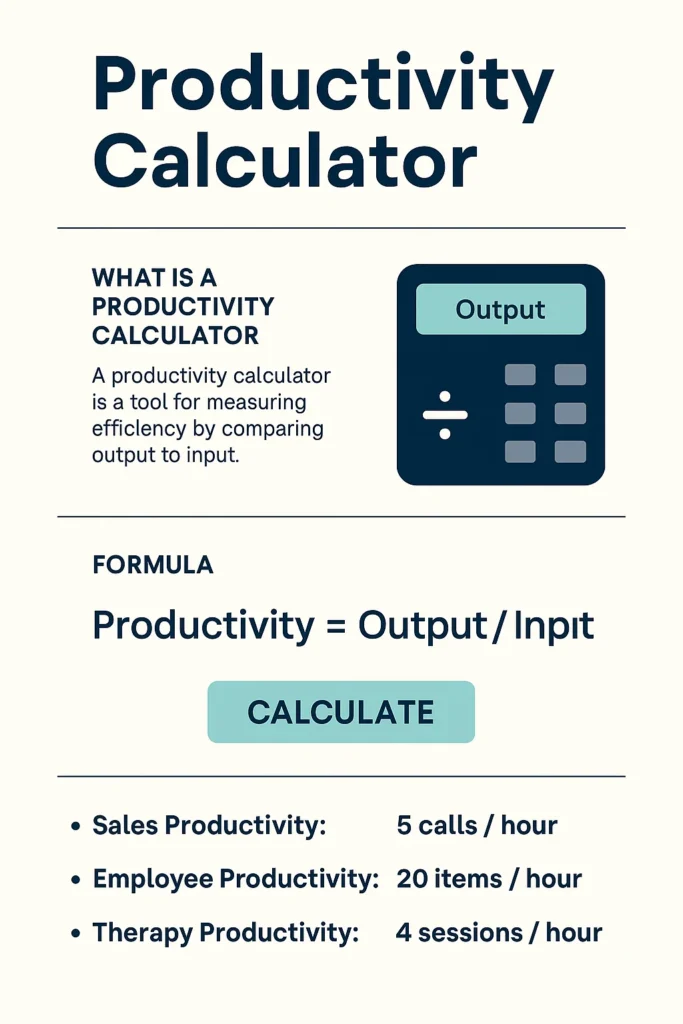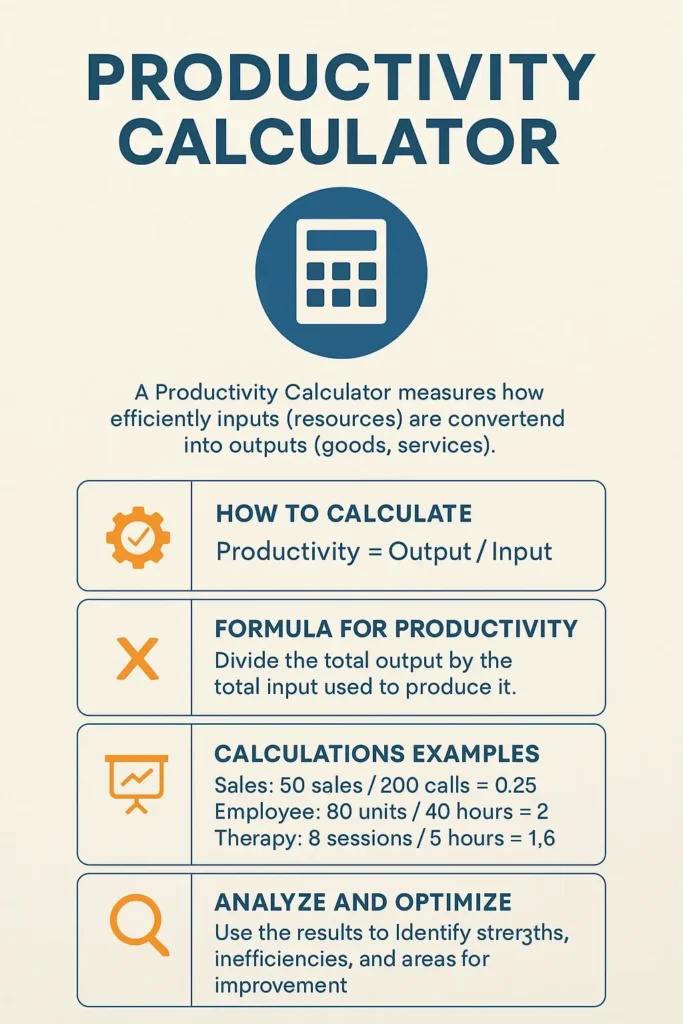Productivity Calculator
Your Productivity Results
Explore other calculators
- Therapy Productivity Calculator
- Sales Productivity Calculator
- Employee Productivity Calculator
- Labor Productivity Calculator
- Productivity Percentage Calculator
- Healthcare Productivity Calculator
- Rehab Productivity Calculator
- Productivity Index Calculator
- Productivity Growth Rate Calculator
- Multifactor Productivity Calculator
- Machine Productivity Calculator
- Total Factor Productivity Calculator
- Productivity Loss Calculator
- Marginal Productivity Calculator
- Welding Productivity Calculator
- Net Primary Productivity Calculator
- Laboratory Productivity Calculator
What is a Productivity Calculator?
A Productivity Calculator is a versatile tool that measures how efficiently you’re turning your resources into valuable output. It helps you analyze your work processes, identify areas for improvement, and track your progress over time. Whether you’re working in sales, healthcare, education, or any other field, understanding your productivity is essential for staying competitive and driving success.
These calculators are popular across industries because they simplify complex calculations. Instead of manually crunching numbers, a productivity calculator does the heavy lifting for you. In today’s fast-paced work environment, it’s crucial to find ways to save time and maximize results and our calculator is here to help.

How is Productivity Calculated?
The question of how is productivity calculated is crucial in any industry. The fundamental principle of productivity measurement is simple:
Productivity = Output / Input
This means you’re comparing what you produce (output) to the resources you use (input).
For example:
- A sales team might compare the number of sales closed (output) to the number of hours worked (input).
- A therapist might look at the number of sessions completed (output) compared to the hours worked (input).
By entering your data into our Productivity Calculator, you get precise, actionable insights in seconds.
For a more detailed explanation of productivity measurement across sectors, check out this informative OECD guide on measuring productivity. It’s a great resource for understanding how productivity is defined and measured globally.
Formula for Productivity
The formula for productivity is straightforward and can be adapted to any industry:
Productivity = Total Output / Total Input
This formula can be used in a variety of contexts, from tracking an employee’s productivity to analyzing company-wide efficiency. For instance, if your team produced 300 units in 50 hours:
Productivity = 300 / 50 = 6 units per hour
It’s that easy! Our calculator uses this formula behind the scenes to save you time and deliver instant results.

Productivity Calculations Examples
To make things clearer, here are some productivity calculations examples that illustrate how the formula works in real-life situations:
✅ Sales Productivity: A team makes 500 calls in 100 hours.
500 / 100 = 5 calls/hour
✅ Employee Productivity: A factory produces 1,200 items in 60 hours.
1,200 / 60 = 20 items/hour
✅ Therapy Productivity: A therapist sees 40 patients over 10 hours.
40 / 10 = 4 sessions/hour
These examples show how productivity calculations can help you identify strengths, spot inefficiencies, and improve your workflow.
Why Use a Productivity Calculator?
✅ Fast and Accurate: Get instant insights without complicated spreadsheets.
✅ User-Friendly: No technical expertise needed—just enter your data and calculate!
✅ Free and Accessible: No sign-ups or hidden fees.
✅ Customizable: Use it across different sectors and tailor the inputs to your specific needs.
In today’s competitive environment, being able to quantify productivity is essential. Businesses rely on these metrics to make data-driven decisions and stay ahead of the curve.
Broader Applications and Benefits
Productivity calculators are used across a wide range of industries, including:
- Healthcare: Tracking patient visits and therapy session productivity.
- Sales and Marketing: Measuring calls, conversions, and revenue per hour.
- Manufacturing: Monitoring output in factories and warehouses.
- Rehabilitation and Therapy: Assessing patient engagement and progress.
Beyond industry-specific applications, productivity calculators help you:
- Set realistic performance targets.
- Benchmark your productivity against peers.
- Optimize workflows to save time and money.
Reduce stress by providing clear metrics and eliminating guesswork.
Unlock Your Full Potential
Our Productivity Calculator can revolutionize your workflow by helping you:
Highlight your strengths and top-performing areas
Uncover inefficiencies and potential bottlenecks
Monitor progress and growth over time
Make informed, data-driven decisions to enhance performance
